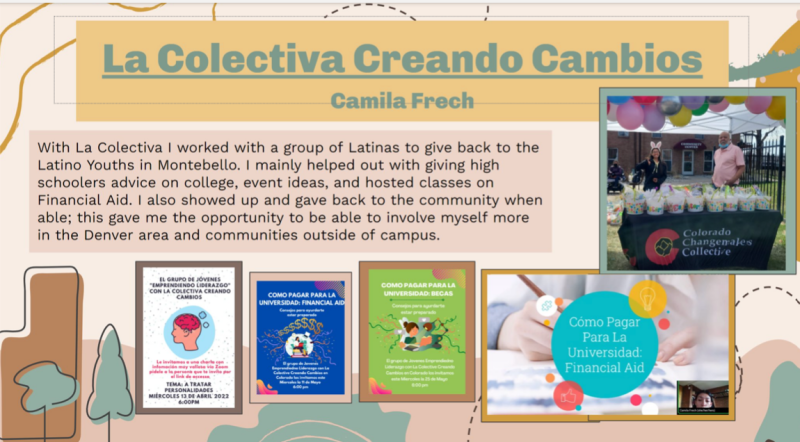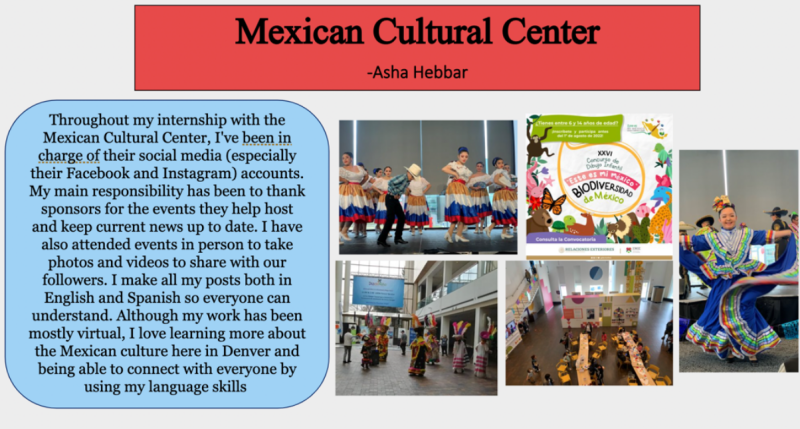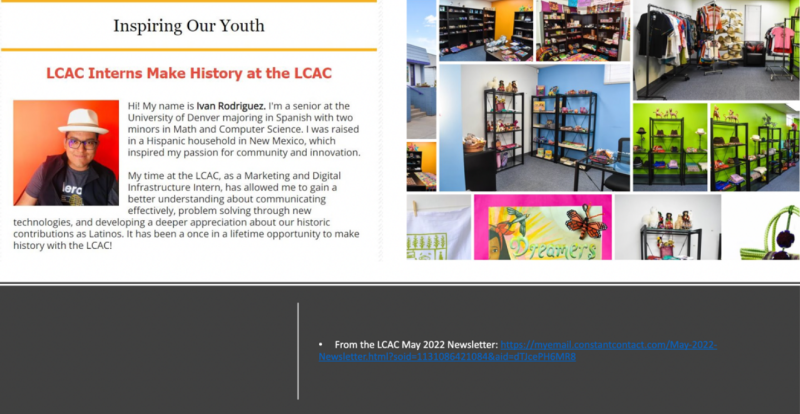It’s The Little Things That Matter: Re-Engaging “The Big Ideas” in Community-Engaged Teaching
By: Lina Reznicek-Parrado, Spanish Language, Literary and Cultural Studies

Community-engaged teaching (CET) has been part of my pedagogical practice ever since my training in graduate school, several years before coming to DU. As such, the AY 21-22 was a community-engaged teaching dream year for me. But at the beginning of my work with the Engaging Onward Faculty Learning Community in Fall Quarter, the horizon was meek, the pandemic still loomed, and I had no plan. The “big ideas” I had carried with me throughout my first years teaching at DU seemed unreachable, I had no community with whom to workshop and no community partners with whom to collaborate. The only big idea that seemed to continue pushing me forward was the overly abstract conviction that there was some level of potential to develop engaging collaborations that could provide meaningful work outside of the classroom for all students taking Spanish at DU. But it felt so unreachable.
It was filled with fear and a lack of energy that I joined CCESL’s Engaging Onward Faculty Learning Community on the first meeting of Fall Quarter. Early in the interaction with colleagues across campus with various experiences doing CET, I realized that one of the biggest obstacles I had to overcome before I could move forward was my insistence on attaching to “big ideas”. Rather, colleagues encouraged me to consider how “the little things” have great relevance in how a CET project is moved forward. I realized then that I needed to get to work on those “little things”—ask questions about establishing relationships with community partners, brainstorm regarding how others have been able to nurture those relationships, listen to stories of success as well as stories of projects that failed, etc. All of those “little steps”, colleagues assured me, while many times invisible, are crucial in moving CET projects forward. Celebrating “little successes” were many times what kept a project on its feet, they shared, regardless of how invisible they become once a project gained visibility.
With a sense of renewed energy, and the realization that this group of colleagues were an incredible asset, I volunteered to facilitate our second Fall Quarter meeting. While colleagues thanked me for volunteering, I actually considered the move a selfish one; my intention was to, during our conversation, use the group and the many experiences of my CET colleagues to give me ideas on how to begin, through “little steps”, building community partnerships relevant to the CET projects I had in mind. I was open to the group about my self-centered motivation and was reassured that my intention was indeed part of the work we were there to do together. I quickly began to take note of all the “little ideas” shared: the importance of establishing clear guidelines and expectations to share with partners through a collaborative, shared MOU; collecting a live schedule of relevant events where networking can happen; establishing the goal of meeting at least one potential partner per event; the possibility of including students in the development of partnerships—and so many more! Suddenly, I had a list of “little things” that seem reachable, realistic and most importantly, relevant. It was reenergizing.
That simple first interaction with the Engaging Onward Faculty Learning Community was the catalyst for my CET efforts within my program. In early Winter, I endeavored to make connections in the community. I networked. I asked questions. I sent e-mails. I did little things and I had little ideas. All of a sudden, towards the end of Winter Quarter, I had a database of at least 15 community partners who had communicated their interest in hosting bilingual DU undergraduates to support their varied missions. It was thrilling—I had gone from zero community partners to over 15 local non-profits, private firms, government offices and other institutions who directly serve Spanish-speaking communities and were eager to collaborate; partners that shared many of my own pedagogical goals and who I knew would offer relevant opportunities that relate to the Public Good. Beyond that, I realized that the initial potential I felt was true; that I could create a CET project where my own bilingual/heritage students would have the opportunity to interact with the communities we were learning about in the classroom and were going to be able to critically apply their knowledge about language use to relevant, socially and community-engaged issues.
With the help of CILCA (Center for Innovation in the Liberal and Creative Arts), 19 DU students were placed in 19 different community partners in Spring, including, but not limited to: The Latino Cultural Arts Center, Habitat for Humanity of Denver Metro, El Grupo Vida, Mi Casa Resource Center, Alzheimer’s Association of Colorado, Aurora Community Connection and Family Resource Center, Changemakers Coalition of Colorado, Mexican Cultural Center, the African Chamber of Commerce, and more. Following a “paid internship” model, students were required to spend at least 40 and up to 80 hours throughout the Spring quarter at their matched site. Through the opportunity, students developed career-relevant skills with programs that directly serve bilingual communities; many times, the same communities from which they come. The opportunity not only pushed students to leave the classroom walls and interact with the greater Denver community, but also to build knowledge about the linguistic and cultural diversity that is all around us and which we study in the classroom. Some of the reflections from students echo the benefits of their experience:
“It is exactly what I need right now. Not too demanding, but a way for me to get involved in the community off of campus and helping them (Latinx youth). I am currently planning a tour of DU and a Ways to Pay for College Course. I think the hardest part is that I didn't realize the organization is completely in Spanish, and my Spanish isn't the best, but it is helping me get better and practice more.”
“My internship has been going very well. I love the staff at Aurora Community College and I appreciate their core values. I have been working with the Diversity, Equity and Inclusion Department and their Undocu-serving task force which has been very interesting. I love the diversity at this school which is much different than that of DU.”
A couple of examples from our End-of-Year Showcase were students shared some of the work:
I am grateful to the Engaging Onward Faculty Learning Community for helping me re-engage with the “little things that matter”—for providing much-needed support, conversation and ideas that helped me re-engage my CET agenda, and my ability to connect, create and inspire though big ideas.





